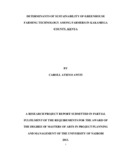| dc.description.abstract | The sustainability of greenhouse farming has been a major concern worldwide as
countries like Canada have emphasized on the use of integrated pest management
strategies rather than the use of pesticides, other countries like Netherlands have looked
at how technical knowhow of their farmers can be improved, how efficient use of water
can be achieved and how energy can be used more efficiently. In Kenya according to
KARI (Kenya Agricultural Research Institute) sustainability is still faced by many
challenges including lack of technical back up on the innovation. In Kakamega County
30% of farmers own greenhouses but after a period of 2 to 3 years only 5% of them still
own these greenhouses despite the fact that a comparison done worldwide through
literature review shows that the uptake of this technology is increasing. The purpose of
the study was to investigate the determinants of sustainability in greenhouse farming
technology amongst farmers in Kakamega County, Kenya. This study was guided by the
following objectives: To determine how integrated pests and disease management
influence the sustainability of greenhouse technology in Kakamega County, To assess
the extent to which utilization of energy influences the sustainability of greenhouse
farming technology among farmers in Kakamega County, to examine how modern
irrigation influences the sustainability of greenhouse farming technology and, to establish
the level at which technical training influence the sustainability of greenhouse technology
among farmers in Kakamega County. Descriptive survey design was used. The sampling
frame of 202 was provided by the County Director of agriculture Kakamega, where a
sample size of 132 farmers was identified using the Krejcie and Morgan (1970) formula
for determining the sample size. The study used questionnaire to collect data. Pilot testing
was used as an important step in making the instrument reliable for the purpose of the
study. The Cronbach‟s coefficient for determination of reliability of data collection
instruments was calculated as 0.769. Both descriptive and inferential statistics were used
to analyze data. The study established that there was a significant positive correlation
between the results seen with the integrated pest and disease management system and the
sustainability of greenhouse farming technology in Kakamega County (N=127; r=0.47;
p˂0.01). A significant positive correlation was also noted on whether or not a farmer had
challenges with the integrated pest and disease management system and the sustainability
of greenhouse farming in Kakamega County (N=127;r=0.57; p˂0.05). The analysis
established that there was a significant positive correlation between the utilization of
renewable energy and sustainability of greenhouse farming technology in Kakamega
County (N=127;r=0.32; p˂0.05).There was a significant positive correlation between the
use of modern irrigation systems and the sustainability of greenhouse farming technology
in Kakamega County (N=127;r=0.29; p˂0.05).There was also a significant strong
positive correlation between technical training of farmers and sustainability of
greenhouse farming technology in Kakamega County (N=127;r=0.61; p˂0.05).The study
recommends sensitization and strengthening on: the concept of integrated pest and
disease management system in greenhouse farming technology, benefits of utilizing the
renewable energy sources as a way of further reducing the cost of fuel used in the
greenhouse farming technology and, adoption of modern irrigation system to enhance the sustainability of greenhouse farming technology. | en_US |

